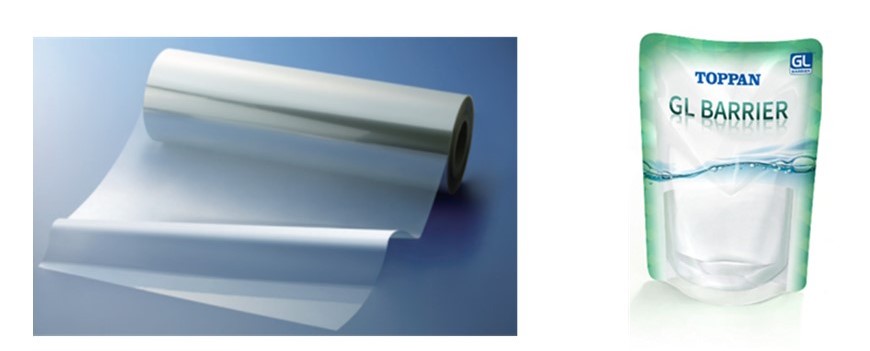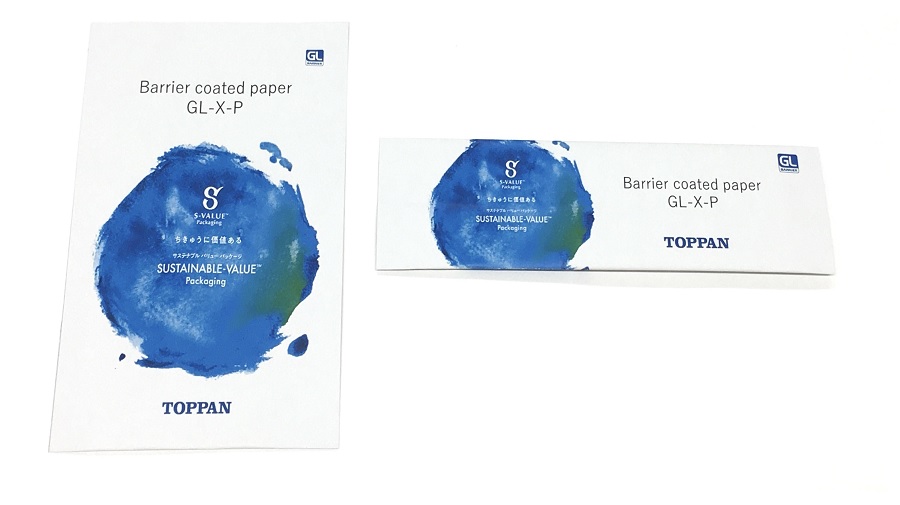
© TOPPAN INC.
Tokyo – October 27, 2021 –Toppan (TYO: 7911), a global leader in communication, security, packaging, décor materials, and electronics solutions, provides packaging that uses GL BARRIER, a leading brand of transparent barrier film that enables reduction of CO₂ emissions when used as an alternative to aluminum foil.
Toppan has quantified reduction in CO₂ emission volume, and, to strengthen its efforts in the area of eco-friendly packaging that contributes to decarbonization, calculated CO₂ emission volume in fiscal 2020 from shipments of retort food pouches and mono-material food pouches with spouts that use GL BARRIER. The results indicate a reduction in CO₂ emission volume of approximately 63,000 metric tons when compared with packaging that uses aluminum foil.1 This is equivalent to the volume of CO₂ emitted annually by about 23,000 households.2
To accelerate efforts to supply optimal packaging that minimizes CO₂ emissions and provides outstanding functionality, Toppan has also developed SmartLCA-CO₂™, a system for automated calculation of CO₂ emission volume across the entire package life cycle of individual products based on Life Cycle Assessment (LCA).3 The system will be launched at Toppan’s core plant for flexible packaging in Gunma, Japan, in November this year. Toppan will take advantage of the system to propose packaging specifications that minimize CO₂ emissions to manufacturers in such sectors as food, toiletries, and pharmaceuticals.
Targeting a decarbonized society, Toppan aims to drive greater visibility of CO₂ emission volumes and contribute to emission reduction by advancing a shift to GL BARRIER, including mono-material packaging, and optimizing package design.
Background and product overview
With growing momentum globally in the areas of eco-friendliness and resource saving driven by initiatives including the Sustainable Development Goals (SDGs), attention is focused on packaging that reduces environmental impact. Toppan’s Medium Term Plan, announced in May this year, sets out a vision of contributing to a sustainable society and enhancing corporate value as a leader in providing solutions on a global scale through Digital Transformation (DX) and Sustainable Transformation (SX). One of the priorities identified is initiatives focused on the environment, and Toppan is addressing this through its business.
With the TOPPAN S-VALUE™ Packaging range at its core, Toppan’s packaging business is accelerating provision of SUSTAINABLE-VALUE Packaging™, which is based on the concept of generating value for Earth. The adoption of GL BARRIER as an alternative to conventional aluminum foil materials for retort food packaging has expanded significantly because it enables reduction in CO₂ emissions and can be used in microwave ovens.
Demand for polypropylene (PP) barrier film is growing in North American and European markets, where a shift to mono-material packaging is underway, and aluminum foil used for such items as food pouches with spouts is being replaced with GL-BP, a PP-based version of GL BARRIER. Toppan aims to contribute to a sustainable society by accelerating initiatives based on quantifying and visualizing reduction of CO₂ emission volume in relation to these and other products seeing increased demand.
About GL BARRIER
GL BARRIER is Toppan’s range of transparent films providing world-class barrier performance. The multilayer structure of GL BARRIER films combines unique coating and vapor-deposited layers to enable outstanding, stable barrier performance relied upon for a wide range of items in the food, medical, pharmaceutical, and industrial materials sectors. GL BARRIER makes it possible to replace aluminum foil and streamline layer structure by combining the functions of the printing substrate and barrier substrate and also enables packaging to be heated in microwave ovens.
About GL-BP
Heat and humidity negatively affect the performance of conventional barrier films using oriented polypropylene (OPP). With GL-BP, Toppan has enhanced water vapor barrier performance, reduced the impact of changes in heat and humidity, and achieved oxygen barrier performance superior to that of conventional OPP-based barrier films even under high humidity. When used in combination with other OPP-based materials, it enables mono-material packaging that is more readily recyclable. Toppan will strengthen sales of GL-BP globally and contribute to mitigating environmental impact by reducing CO₂ emission volume and improving recyclability.
About SmartLCA-CO₂™
SmartLCA-CO₂ uses LCA to calculate CO₂ emission volume over the entire life cycle of a package. Emissions can be calculated for each product provided by customers, enabling Toppan to propose specifications that minimize CO₂ emission volume while maintaining the functions required of the packaging.
About TOPPAN S-VALUE™ Packaging


Solutions that function as a medium for communication to maximize the customer experience. Toppan provides optimal value for various aspects of everyday life, enabling smooth purchasing, efficient storage, preparation of tasty food, easy disposal, safety, peace of mind, and more.

Packaging and services generating value that helps to sustain business activities by enhancing efficiency in the supply chain, raising productivity, optimizing sales, and providing solutions to wide-ranging challenges.

Solutions that help drive reduction of environmental impact and create a circular economy. Toppan offers packaging using recycled plastic, mono-material packaging that enhances recyclability, and packaging using plant-derived materials such as paper and biomass plastic.
Website https://www.toppan.co.jp/living-industry/packaging/english/sustainability/
2. Based on the results of statistical research by the Japanese Ministry of the Environment on household CO₂ emissions in 2019.
http://www.env.go.jp/earth/ondanka/ghg/kateiCO2tokei.html (in Japanese)
3. Life Cycle Assessment is a method for quantitative assessment of resources input and environmental impact of emissions across the entire life cycle of a product, from raw materials (resource extraction to raw material manufacture) to product manufacture, use, recycling, and disposal.
About Toppan
Established in Tokyo in 1900, Toppan is a leading and diversified global provider committed to delivering sustainable, integrated solutions in fields including printing, communications, security, packaging, décor materials, electronics, and digital transformation. Toppan’s global team of more than 50,000 employees offers optimal solutions enabled by industry-leading expertise and technologies to address the diverse challenges of every business sector and society and contribute to the achievement of shared sustainability goals.
For more information, visit https://www.toppan.com/en/ or follow Toppan on LinkedIn https://www.linkedin.com/company/toppan/.



